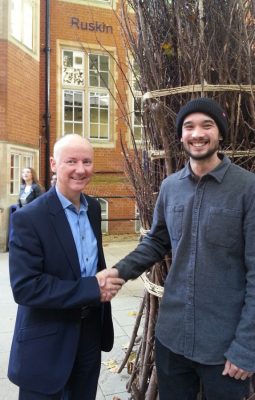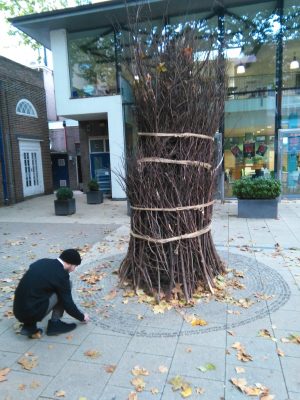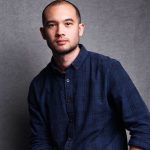
Head of Art at Anglia Ruskin University Chris Owen and Kenji Lim at ARU
Sara Lerota talks to award winning artist Kenji Lim about his work:
Just as meeting Kenji in person was much more vivid than communicating with him via e-mail, seeing his work live was so much more intense than seeing it in photos. In both cases, the same feeling of calmness, sense of focus and pure dedication to the cause was present. The connection between Kenji and his work is obvious in more than one way and that adds value to the authenticity of his expression.
Somehow, it was very easy for viewers to immerse themselves into the story of Kenji’s work, to breathe in the atmosphere of “Daughters” and even express their own projections and thoughts about the work. There was no doubt that Kenji’s work would cause reactions from the moment it started to develop on the first day of ALL2015, but it was nice to see that with the progress of his work the number of conversations and exchanges of thought related to it increased also.
Kenji Lim is one of the 70 artists who participated in this year’s Art Language Location – an annual art festival which, for the fourth year in a row, brings artists to Cambridge and gives them the opportunity to express themselves and create work related to text. The festival is a must-see presentation of the contemporary UK art scene of today, including works by Tom Hackett, Joseph Young, Kimvi Nguyen, Jonathan Rogerson and many more emerging and established artists from across the UK and beyond.
Art Language Location was an excellent opportunity for Kenji to develop his work and show it to an audience in a very appropriate environment of the Anglia Ruskin University campus.
The name of the work is “Daughters”. It is inspired by his original story “The Squire’s Daughters” but includes additional elements which bring it far away from being just a reproduction. The continuity of work – which evolved until the last day of the festival – and its vulnerability to weather, passing foot traffic and other elements makes it related to the nature of storytelling, fairytales and all the mysteries behind them.

Kenji Lim updates the story
In the words of the artist: “The fairy tale is an original story, The Squire’s Daughters, which has as it’s inspiration the real life trial of the Witches of Warboys in 16th century Cambridgeshire. The wood bundle is reminiscent of a witches broom and also brings to mind the forest which many tales involving witches are set in. Its location in the courtyard brings to mind a theatre or arena, where stories could be told or justice meted out to witches and heretics. As the text is weathered away we are reminded of the nature of storytelling and of memory. A fairytale is not a text, and it must change as the teller changes. As it is spoken it disappears and must be remembered to be passed on.“
Even though Kenji Lim has a very detailed description of his work and a strong direction in which it develops, he was interested to hear thoughts from the audience and how it appeared from their perspective. Every single one of them had their own view on the subject, all related to core ideas of the work (including woods, stories, mystery etc.), but all very different. However, there was no doubt that they were all impressed by the visual aspect of his work and even more by its meaning and background story.
“Viewers have stopped to read what text they can, and formed their own opinion on its content, some unwilling to engage in the physical act of circling the bundle that is required. The story in so many parts is long and the difficulty for repeat visitors of discovering the full content has in many cases been described by them as frustrating. There is a desire to know the story, to glean some form of meaning from it, or for a fuller understanding of where the events they are reading about fit into an overall scheme. There is a real desire to know more, and the glimpses of these characters may not satisfy. In many ways this is what is seen by academics researching ancient manuscripts and stories, where only fragments are available and that sometimes this will be enough to form some kind of narrative, but sometimes not.”
Also, as the work progresses, a dose of unpredictability is present and it is interesting to see the artist’s point of view on those form variations.
“The process of the writing has been a very interesting aspect for me. The visual way that the ring around the branches has been expanding feels like a ripple, or even like a fungal organism spreading out across the paved surface. The way that the words have disappeared because of the the rain have left the words that are written hanging in space in the mornings, freshly written, and quickly the footsteps of people walking over them has broken the ring and left it as a memory, not only the memory of the writing, but a memory of their passing. Because of the swift disappearance of the text, the content of the story has been somewhat overshadowed.”
Kenji was expanding his work every day until 1st November 2015 so this collaboration between him and Art Language Location was an excellent opportunity to see both his work in situ and the 69 works by other participating ALL2015 artists. The content at Art Language Location 2015 was so extraordinary that even thinking about ALL2016 brings one into a pleasant expectancy!

Kenji Lim is a British artist living and working in Herefordshire, England. He studied at Ruskin School of Drawing and Fine Art, University of Oxford, 1999-2002. He works as both an Artist and Illustrator, both sides of which are represented in his website.

Sara Lerota was born in 1989, in Mostar, Bosnia and Herzegovina. She represented her country by participating in a world art project “PLUS YOU“ which brought together artists from all over the world and which was organised by Brigitte Williams and exhibited at Woburn Studios (Slade-UCL) in London. She was selected by the Broadway Artists Group (BAG) as one of the Winners of the Art On Call (AOC) Awards and received the most votes from AOC Popular Choice Poll Awards for her pencil work.
Her works have been published in the Cut-Click art and design magazine (UK), the Catapult art magazine (USA), Artists Gone Global book (USA) and have appeared in exhibitions in the United Kingdom (London, Nottingham, Brighton, Wimbledon, St. Leonards, Swindon, Walthamstow, Bath, Croydon…), Spain, Croatia, Portugal, Serbia, Bosnia and Herzegovina, Germany, USA etc.
Sara´s favourite mediums are pencils and pastels, but she´s still discovering all the benefits of acrylics and is open to using other mediums in a search for a perfect tool for expressing her ideas. She is a member of “Art on Call” art organisation from L.A., California (USA), a member of DHLU (Mostar, BiH) and a committee member of “Art Language Location” (Cambridge, UK).





No Comments Yet!
You can be first to comment this post!